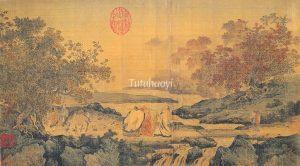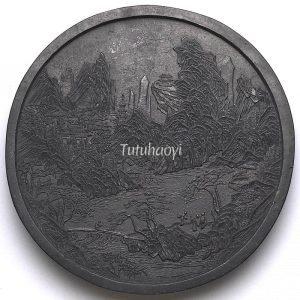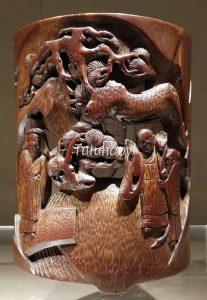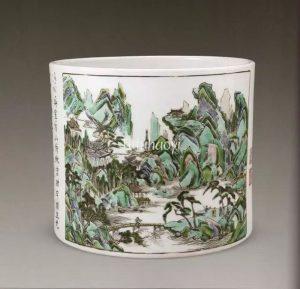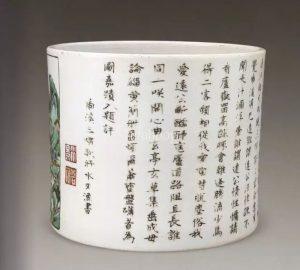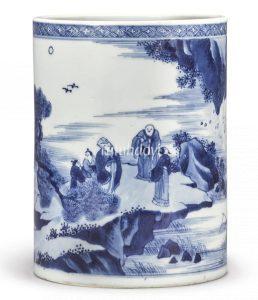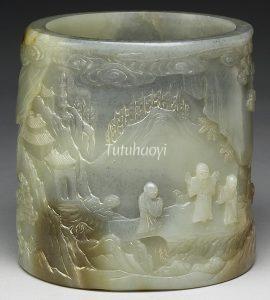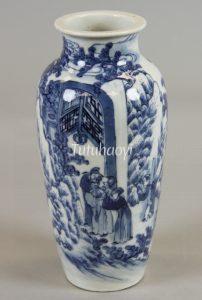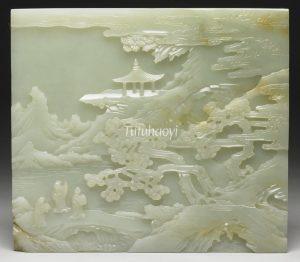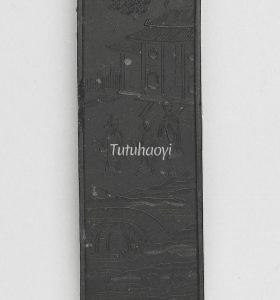Three men laughing by the Tiger Creek
虎溪三笑
© Tutuhaoyi.com owns the copyright of the description content for the images attached. Quoting all or part of the description content on this page is permitted ONLY IF ‘Tutuhaoyi.com’ is clearly acknowledged anywhere your quote is produced unless stated otherwise. (本页描述内容版权归Tutuhaoyi.com所有,转发或引用需注明 “Tutuhaoyi.com”, 侵权必究, 已注开源信息的条目除外。)
The tale of Three men laughing by the Tiger Creek was already circulating during the Tang dynasty and gained widespread popularity in the Song dynasty.
According to legend, Huiyuan 慧远 (334–416), the abbot of Donglin Temple on Mount Lu, was known for never seeing his guests off beyond the bounds of Tiger Creek. However, on one occasion, after a delightful gathering with Tao Yuanming 陶渊明 (365–427), a retired magistrate and renowned poet, and Lu Xiujing 陆修静 (406–477), a Daoist master, the three became so deeply engaged in conversation that they unknowingly crossed the stream’s boundary. It was only when a tiger roared from the nearby hills—traditionally believed to guard the threshold—that they realised they had overstepped it. The moment brought a sudden and shared laughter, marking a gentle yet profound farewell.
Despite the charm of this story, historical evidence casts doubt on its authenticity. While it is plausible that Huiyuan and Tao Yuanming, contemporaries in the Eastern Jin period, may have met, Lu Xiujing lived nearly a century later, making such a meeting historically impossible. Thus, the episode is regarded as a fictional creation.
Nevertheless, the tale has endured through the centuries as a poetic symbol of unity and mutual respect among the three major schools of thought in Chinese tradition—Confucianism, Buddhism, and Daoism.
image identification and story scene description by Dr Yibin Ni
Similar Figural Story Scenes for Differentiation:
Confucius consulting Laozi 孔子见老子
Zhang Liang Fetching Shoe on Yi Bridge 张良圯桥纳履 (圯桥三进履)
Fig 1: album leaf, ink and colour on silk, anonymous, Southern Song (1127–1279), courtesy of the National Palace Museum, Taipei
Fig 2: fan leaf, ink on paper, Zhang Longzhang, Ming dynasty (1368–1644), courtesy of the National Palace Museum, Taipei
Fig 3: ink cake, Ming dynasty (1368–1644), courtesy of the National Palace Museum, Taipei
Fig 4: bamboo brush pot, late Ming – early Qing dynasty, courtesy of Jiading Museum, Shanghai, China; Photograph by Rachel Ma
Fig 5-6: famille verte brush pot, Kangxi period (1662–1722), Qing dynasty, courtesy of the Palace Museum, Beijing
Fig 7: brush pot with underglaze blue decoration, Kangxi period (1662–1722), Qing dynasty, courtesy of Sotheby’s Auction House, New York, 20 March 2018, Lot 311
Fig 8: jade carving, Qing dynasty (1644–1911), courtesy of the National Palace Museum, Taipei
Fig 9: porcelain vase with underglaze blue decoration, Qianlong period (1736–95), Qing dynasty, courtesy of the Metropolitan Museum of Art, New York
Fig 10: jade carving, Qing dynasty (1644–1911), courtesy of the National Palace Museum, Taipei
Fig 11: ink stick, Qing dynasty (1644–1911), courtesy of the National Palace Museum, Taipei
